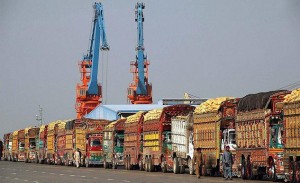Gawadar Port – Another major route for drug trafficking
Saturday, October 29th, 2011 7:32:33 by Khayyam Bokhari
The report titled ‘The global Afghan opium trade: A threat assessment’ released by the UN Office for Drugs and Crime (UNODC) after a case study on trafficking through Balochistan and Fata said the spot of Gwadar port endowed with
an break to subvert trade sanctions on Iran.
It said the rapid rise in trade volume transiting the region was likely to engulf the customs and law-enforcement agencies and the port’s surrounding area to regional trade centers would most likely see Gwadar targeted by illicit
traffickers.
Apart from official ports, a major volume of drugs is trafficked by sea from Balochistan at various unofficial points along the Makran coast. Key exit points along the coast include Ormara, Talar, Hingol, Sur Bander, Peshukan and
Jiwani, although Kund Malir in Lasbela district and Jirwani in Gwadar are reported to be the most vital unofficial natural jetties used by drug traffickers.
It is estimated that most of the heroin reaching Pakistan is trafficked through the Helmand and Kandahar borders with Balochistan because of limited law-enforcement capacity on both sides of the border and the strong presence of
Taliban and other anti-government elements.
Despite being the main entry point and transit route, there is no strong evidence that heroin processing take place in Balochistan. Heroin laboratories have been identified along the unclear Afghan border but it has not been confirmed
whether any of them is in Pakistani territory.
According to the report, Pakistani criminal groups paid an estimated $400 million to Afghan drug traffickers for 160 tons of heroin that entered the country. They then sold 138 tons to international traffickers for $700 million,
making a $300 million profit.
Pakistanis consumed 20 tons of Heroin at a street price of $400 million. For consumption of some 132 tons of raw opium, users paid about $95 million to drug traffickers. In total, Pakistan’s opiate market was worth $1.2 million
in 2009 including both transitional trafficking and domestic consumption with Pakistani drug traffickers making a net profit of $650 million.
The exact beneficiaries of the opiate trade through Pakistan are difficult to specify, although it appears that extremist groups in Fata and criminal groups in Balochistan are key recipients, according to the study. Heroin trafficked
from Pakistan met the majority of demand in the near and Middle East Asia.
During the year, 17 to 18 tons of heroin was consumed in the region 16 tons in Iran and one to two tons in Israel, Saudi Arabia, Jordan, Lebanon and Kuwait.Heroin was brought into these countries mainly across the coastline of
Pakistan especially via the UAE using speedboats and other marine transport.
Drugs and precursor chemicals are transported across the Pakistan-Iran border on motorbikes, camels, donkeys and in small caravans of two or three vehicles. They are also concealed in specially designed vehicle cavities or in bags
and cartons of items meant for legal import.
The report said the large drug trafficking networks of Balochistan did not fully monopolize the market and smaller groups were emerging to capitalize on the perceived easy money. However, they not well connected and are more likely
to be of a criminal nature and ultimately these groups are more frequently intercepted by law-enforcement agencies.
Drug trafficking from Fata to India is less compared to China or Karachi’s international routes, entering India mainly via Sialkot and Wagah.
Tags: Balochistan, drug trafficking, GawadarShort URL: https://www.newspakistan.pk/?p=2010

















